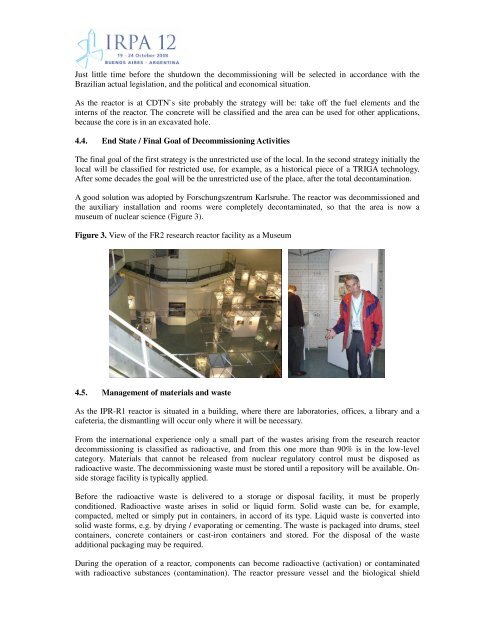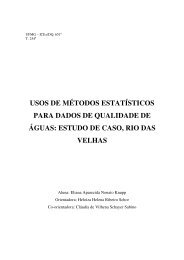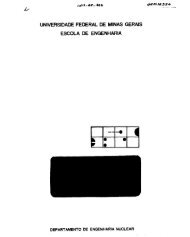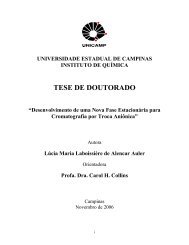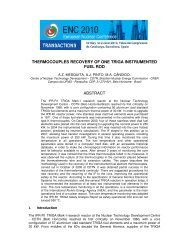ipr-r1 triga research reactor decommissioning plan - CDTN
ipr-r1 triga research reactor decommissioning plan - CDTN
ipr-r1 triga research reactor decommissioning plan - CDTN
You also want an ePaper? Increase the reach of your titles
YUMPU automatically turns print PDFs into web optimized ePapers that Google loves.
Just little time before the shutdown the <strong>decommissioning</strong> will be selected in accordance with the<br />
Brazilian actual legislation, and the political and economical situation.<br />
As the <strong>reactor</strong> is at <strong>CDTN</strong>`s site probably the strategy will be: take off the fuel elements and the<br />
interns of the <strong>reactor</strong>. The concrete will be classified and the area can be used for other applications,<br />
because the core is in an excavated hole.<br />
4.4. End State / Final Goal of Decommissioning Activities<br />
The final goal of the first strategy is the unrestricted use of the local. In the second strategy initially the<br />
local will be classified for restricted use, for example, as a historical piece of a TRIGA technology.<br />
After some decades the goal will be the unrestricted use of the place, after the total decontamination.<br />
A good solution was adopted by Forschungszentrum Karlsruhe. The <strong>reactor</strong> was decommissioned and<br />
the auxiliary installation and rooms were completely decontaminated, so that the area is now a<br />
museum of nuclear science (Figure 3).<br />
Figure 3. View of the FR2 <strong>research</strong> <strong>reactor</strong> facility as a Museum<br />
4.5. Management of materials and waste<br />
As the IPR-R1 <strong>reactor</strong> is situated in a building, where there are laboratories, offices, a library and a<br />
cafeteria, the dismantling will occur only where it will be necessary.<br />
From the international experience only a small part of the wastes arising from the <strong>research</strong> <strong>reactor</strong><br />
<strong>decommissioning</strong> is classified as radioactive, and from this one more than 90% is in the low-level<br />
category. Materials that cannot be released from nuclear regulatory control must be disposed as<br />
radioactive waste. The <strong>decommissioning</strong> waste must be stored until a repository will be available. Onside<br />
storage facility is typically applied.<br />
Before the radioactive waste is delivered to a storage or disposal facility, it must be properly<br />
conditioned. Radioactive waste arises in solid or liquid form. Solid waste can be, for example,<br />
compacted, melted or simply put in containers, in accord of its type. Liquid waste is converted into<br />
solid waste forms, e.g. by drying / evaporating or cementing. The waste is packaged into drums, steel<br />
containers, concrete containers or cast-iron containers and stored. For the disposal of the waste<br />
additional packaging may be required.<br />
During the operation of a <strong>reactor</strong>, components can become radioactive (activation) or contaminated<br />
with radioactive substances (contamination). The <strong>reactor</strong> pressure vessel and the biological shield


